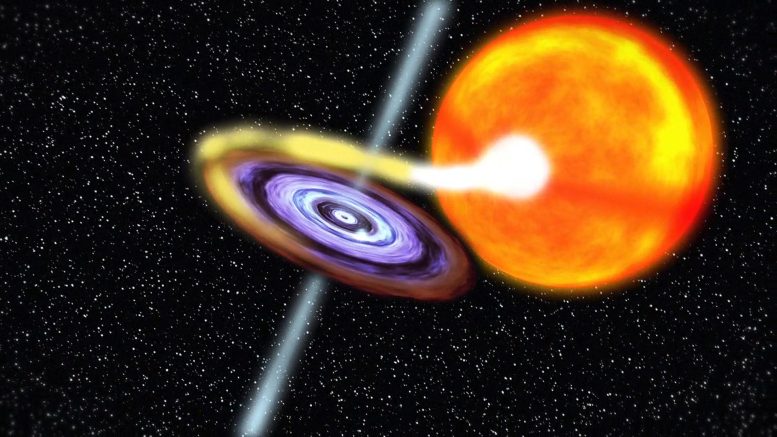
Artist’s interpretation of Swift J1745-26, a newly discovered black hole with a flaring accretion disk. Credit: NASA/Goddard Space Flight Center/Conceptual Image Lab
NASA’s Swift satellite detected high-energy X-rays a few degrees from the center of our galaxy, toward the constellation Sagittarius. Produced by a rare X-ray nova, this outburst announced the presence of a previously unknown stellar-mass black hole that is located 20,000 to 30,000 light-years away.
“Bright X-ray novae are so rare that they’re essentially once-a-mission events and this is the first one Swift has seen,” said Neil Gehrels, the mission’s principal investigator, at NASA’s Goddard Space Flight Center in Greenbelt, Maryland. “This is really something we’ve been waiting for.”
An X-ray outburst caught by NASA’s Swift on September 16, 2012, resulted from a flood of gas plunging toward a previously unknown black hole. Gas flowing from a sun-like star collects into a disk around the black hole. Normally, this gas would steadily spiral inward. But in this system, named Swift J1745-26, the gas collects for decades before suddenly surging inward. Credit: NASA’s Goddard Space Flight Center
An X-ray nova is a short-lived X-ray source that appears suddenly, reaches its emission peak in a few days, and then fades out over a period of months. The outburst arises when a torrent of stored gas suddenly rushes toward one of the most compact objects known, either a neutron star or a black hole.
The rapidly brightening source triggered Swift’s Burst Alert Telescope twice on the morning of September 16, and once again the next day.
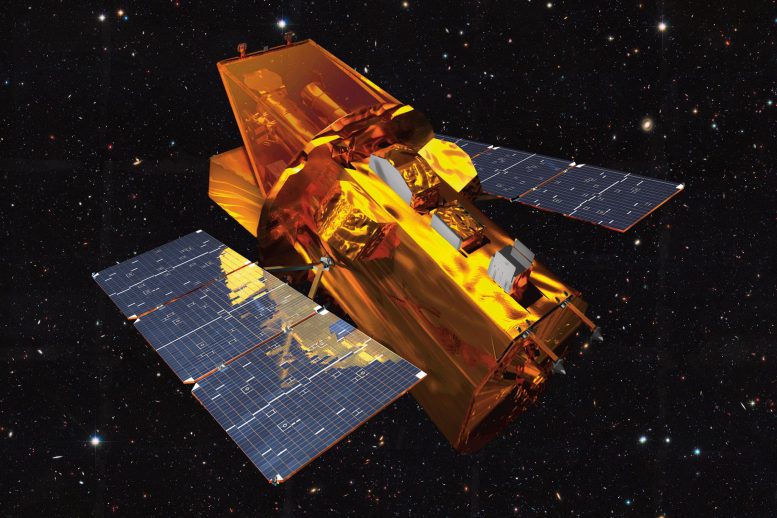
Illustration of NASA’s Swift satellite. Credit: NASA
Named Swift J1745-26 after the coordinates of its sky position, the nova is located a few degrees from the center of our galaxy toward the constellation Sagittarius. While astronomers do not know its precise distance, they think the object resides about 20,000 to 30,000 light-years away in the galaxy’s inner region.
Ground-based observatories detected infrared and radio emissions, but thick clouds of obscuring dust have prevented astronomers from catching Swift J1745-26 in visible light.
The nova peaked in hard X-rays — energies above 10,000 electron volts, or several thousand times that of visible light — on September 18, when it reached an intensity equivalent to that of the famous Crab Nebula, a supernova remnant that serves as a calibration target for high-energy observatories and is considered one of the brightest sources beyond the solar system at these energies.
Even as it dimmed at higher energies, the nova brightened in the lower-energy, or softer, emissions detected by Swift’s X-ray Telescope, a behavior typical of X-ray novae. By Wednesday, Swift J1745-26 was 30 times brighter in soft X-rays than when it was discovered and it continued to brighten.
Artist’s interpretation of Swift J1745-26, a newly discovered black hole with a flaring accretion disk. An X-ray nova is a short-lived X-ray source that appears suddenly, reaches its emission peak in a few days, and then fades out over a period of months. The outburst arises when a torrent of stored gas suddenly rushes toward one of the most compact objects known, either a neutron star or a black hole. Credit: NASA/Goddard Space Flight Center/Conceptual Image Lab
“The pattern we’re seeing is observed in X-ray novae where the central object is a black hole. Once the X-rays fade away, we hope to measure its mass and confirm its black hole status,” said Boris Sbarufatti, an astrophysicist at Brera Observatory in Milan, Italy, who currently is working with other Swift team members at Penn State in University Park, Pennsylvania.
The black hole must be a member of a low-mass X-ray binary (LMXB) system, which includes a normal, sun-like star. A stream of gas flows from the normal star and enters into a storage disk around the black hole. In most LMXBs, the gas in the disk spirals inward, heats up as it heads toward the black hole, and produces a steady stream of X-rays.
But under certain conditions, stable flow within the disk depends on the rate of matter flowing into it from the companion star. At certain rates, the disk fails to maintain a steady internal flow and instead flips between two dramatically different conditions — a cooler, less ionized state where gas simply collects in the outer portion of the disk like water behind a dam, and a hotter, more ionized state that sends a tidal wave of gas surging toward the center.
“Each outburst clears out the inner disk, and with little or no matter falling toward the black hole, the system ceases to be a bright source of X-rays,” said John Cannizzo, a Goddard astrophysicist. “Decades later, after enough gas has accumulated in the outer disk, it switches again to its hot state and sends a deluge of gas toward the black hole, resulting in a new X-ray outburst.”
This phenomenon, called the thermal-viscous limit cycle, helps astronomers explain transient outbursts across a wide range of systems, from protoplanetary disks around young stars, to dwarf novae — where the central object is a white dwarf star — and even bright emission from supermassive black holes in the hearts of distant galaxies.
Swift, launched in November 2004, is managed by Goddard Space Flight Center. It is operated in collaboration with Penn State, the Los Alamos National Laboratory in New Mexico and Orbital Sciences Corp. in Dulles, Virgina, with international collaborators in the United Kingdom and Italy and including contributions from Germany and Japan.

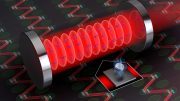

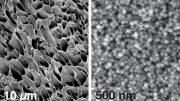
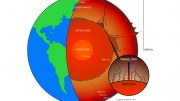



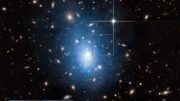
It would almost seem a direct correlation that the suns activity inreased in unison with this event, coincidence or is this a regular occurance?
Sorry! Sun`s activity increases only with sun spot activity which are not cool parts of sun but only magnetic storms which send solar winds outward. The article describes a Sun-like star erupting its gases pulled by adjacent
supernova – here called short lived X-ray nova. It could be some neutron star also nearby. Black holes are extremely dense remnants of died out star losing all its energy collapsing into neutrons. There is no neutron star or supernova near our sun. The experiment is only on some far of galaxies. Please don`t connect solar activity to such cosmic scenes. Thank YOu.